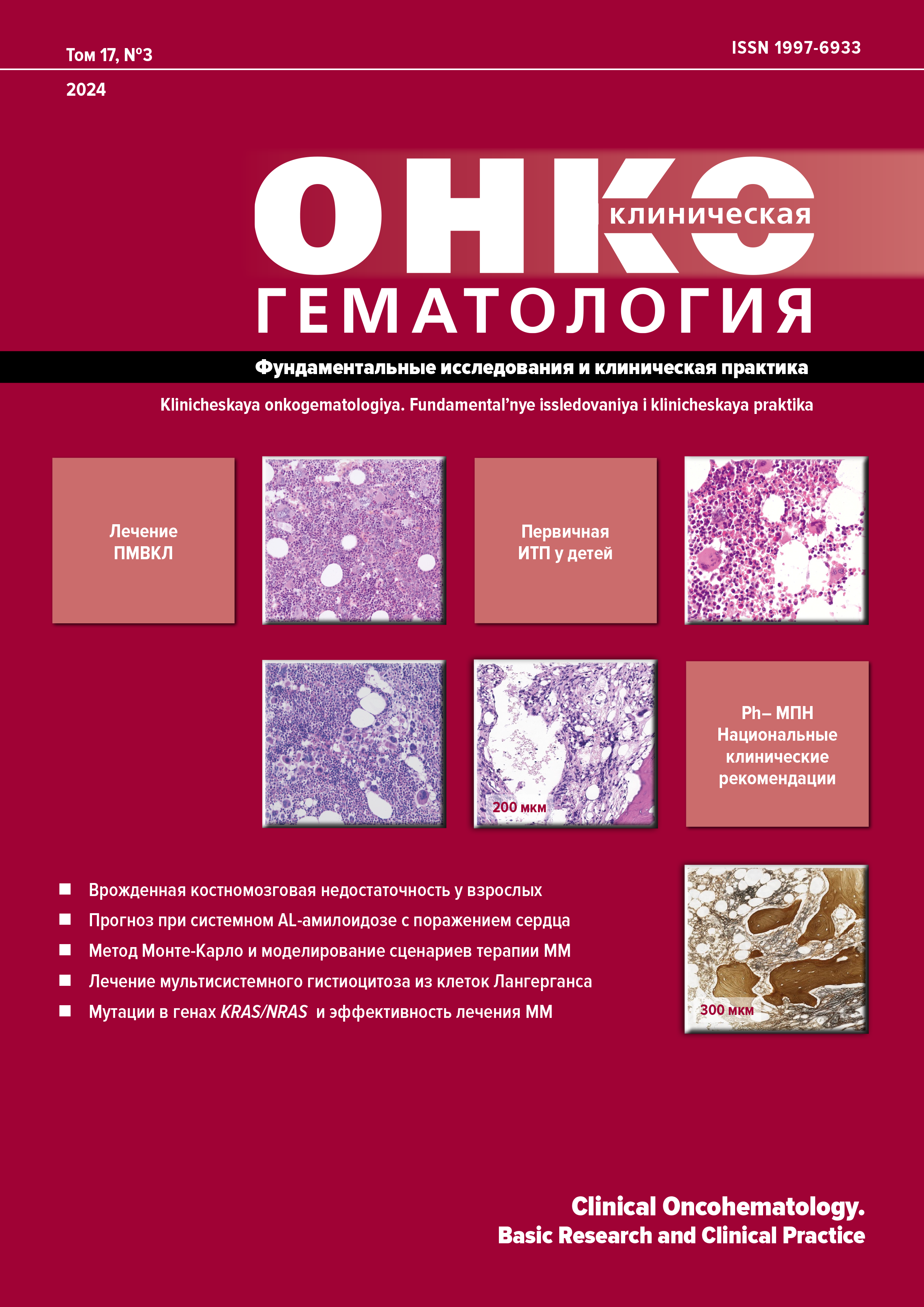Abstract
AIM. To develop an information and retrieval system for hematologists which would enable effective decision making in multiple myeloma (MM) treatment through simulation and prediction of response to therapy considering a patient’s clinical profile-related characteristics and based on the analysis of data from public science sources.
MATERIALS & METHODS. The analysis included 145 therapeutic options and 56,217 MM patients enrolled in 311 clinical studies, the results of which were published in the medical literature from 2003 to 2024. To simulate therapy scenarios, the Monte Carlo method was used for calculating the probability of achieving very good and even better partial response in patients with different characteristics that define not only their clinical profile but also the chemotherapy variants.
RESULTS. This study introduces an interactive online application called М-BОТ (available at oncotriage.ru) enabling to predict response to therapy under certain specified conditions and to visualize the result as real-time ranking of therapeutic options via the user interface. Apart from a patient’s clinical profile-related characteristics underlying MM treatment decision making, it is possible to select trials by their types and numbers of patients enrolled.
CONCLUSION. The therapy recommendations resulted from simulation of different MM therapy scenarios with the use of the Monte Carlo method considerably extend the potential for rapid retrieval of reliable science information which would confirm the optimal choice of a therapeutic option in the given clinical setting. In future, this approach can be regarded as a basis for building up a support system in individual and consensus decision making. It will allow for predicting the efficacy of multi-stage MM treatment strategies with several therapy lines and their safety as well.
References
- Rajkumar SV, Harousseau J-L, Durie B, et al. Consensus recommendations for the uniform reporting of clinical trials: report of the International Myeloma Workshop Consensus Panel 1. Blood. 2011;117(18):4691–45. doi: 10.1182/blood-2010-10-299487.
- Andreozzi F, Dragani M, Quivoron C, et al. Precision Medicine Approach Based on Molecular Alterations for Patients with Relapsed or Refractory Multiple Myeloma: Results from the MM-EP1 Study. Cancers. 2023;15(5):1508. doi: 10.3390/cancers15051508.
- Hanbali A, Hassanein M, Rasheed W, et al. The Evolution of Prognostic Factors in Multiple Myeloma. Adv Hematol. 2017;2017:4812637. doi: 10.1155/2017/4812637.
- Joseph NS, Kaufman JL, Dhodapkar MV, et al. Long-Term Follow-Up Results of Lenalidomide, Bortezomib, and Dexamethasone Induction Therapy and Risk-Adapted Maintenance Approach in Newly Diagnosed Multiple Myeloma. J Clin Oncol. 2020;38(17):1928–37. doi: 10.1200/JCO.19.02515.
- Stewart AK, Rajkumar SV, Dimopoulos MA, et al. Carfilzomib, lenalidomide, and dexamethasone for relapsed multiple myeloma. N Engl J Med. 2015;372(2):142–52. doi: 10.1056/NEJMoa1411321.
- Avet-Loiseau H, Bahlis NJ, Chng W-J, et al. Ixazomib significantly prolongs progression-free survival in high-risk relapsed/refractory myeloma patients. Blood. 2017;130(24):2610–8. doi: 10.1182/blood-2017-06-791228.
- Hosen N. Chimeric antigen receptor T-cell therapy for multiple myeloma. Int J Hematol. 2020;111(4):530–4. doi: 10.1007/s12185-020-02827-8.
- Khanam R, Ashruf OS, Waqar SHB, et al. The Role of Bispecific Antibodies in Relapsed Refractory Multiple Myeloma: A Systematic Review. Antibodies (Basel, Switzerland). 2023;12(2):38. doi: 10.3390/antib12020038.
- Rajkumar SV, Kumar S. Multiple myeloma current treatment algorithms. Blood Cancer J. 2020;10(9):1–10. doi: 10.1038/s41408-020-00359-2.
- Bergin K, McQuilten Z, Moore E, et al. Myeloma in the Real World: What Is Really Happening? Clin Lymphoma Myeloma Leuk. 2017;17(3):133–144.e1. doi: 10.1016/j.clml.2016.12.002.
- Jeon M, Kaufman C, Rabe-Hesketh S. Monte Carlo local likelihood approximation. Biostatistics (Oxford, England). 2019;20(1):164–79. doi: 10.1093/biostatistics/kxx070.
- Kaiser MF, Hall A, Walker K, et al. Depth of response and minimal residual disease status in ultra high-risk multiple myeloma and plasma cell leukemia treated with daratumumab, bortezomib, lenalidomide, cyclophosphamide and dexamethasone (Dara-CVRd): Results of the UK optimum/MUKnine trial. J Clin Oncol. 2021;39(15_suppl):8001. doi: 10.1200/JCO.2021.39.15_suppl.8001.
- Yashar D, Spektor TM, Martinez D, et al. A phase 2 trial of the efficacy and safety of elotuzumab in combination with pomalidomide, carfilzomib and dexamethasone for high-risk relapsed/refractory multiple myeloma. Leuk Lymphoma. 2022;63(4):975–83. doi: 10.1080/10428194.2021.2005044.
- Leypoldt LB, Besemer B, Asemissen AM, et al. Isatuximab, carfilzomib, lenalidomide, and dexamethasone (Isa-KRd) in front-line treatment of high-risk multiple myeloma: interim analysis of the GMMG-CONCEPT trial. Leukemia. 2022;36(3):885–8. doi: 10.1038/s41375-021-01431-x.
- Zhou X, Ruckdeschel A, Peter J, et al. Salvage therapy with “Dara-KDT-P(A)CE” in heavily pretreated, high-risk, proliferative, relapsed/refractory multiple myeloma. Hematol Oncol. 2022;40(2):202–11. doi: 10.1002/hon.2949.
- Weisel K. Isatuximab, Carfilzomib, Lenalidomide, and Dexamethasone (Isa-KRd) in Patients with High-Risk Newly Diagnosed Multiple Myeloma: Planned Interim Analysis of the GMMG-Concept Trial (Internet). ASH; 2022. Available from: https://www.myeloma.org/videos/isatuximab-carfilzomib-lenalidomide-dexamethasone-isa-krd-patients-high-risk-newly-diagnosed (accessed 03.04.2024).
- Mai EK, Benner A, Bertsch U, et al. Single versus tandem high-dose melphalan followed by autologous blood stem cell transplantation in multiple myeloma: long-term results from the phase III GMMG-HD2 trial. Br J Haematol. 2016;173(5):731–41. doi: 10.1111/bjh.13994.
- Mosquera Orgueira A, Gonzalez Perez MS, Diaz Arias JA, et al. Survival prediction and treatment optimization of multiple myeloma patients using machine-learning models based on clinical and gene expression data. Leukemia. 2021;35(10):2924–35. doi: 10.1038/s41375-021-01286-2.
- Zheng B, Yi K, Zhang Y, et al. Multi-omics analysis of multiple myeloma patients with differential response to first-line treatment. Clin Exp Med. 2023;23(7):3833–46. doi: 10.1007/s10238-023-01148-4.
- Settino M, Arbitrio M, Scionti F, et al. MMRF-CoMMpass Data Integration and Analysis for Identifying Prognostic Markers. In: Computational Science – ICCS 2020 Springer; 2020. рр. 564–71. doi: 10.1007/978-3-030-50420-5_42.
- Лучинин А.С. Искусственный интеллект в гематологии. Клиническая онкогематология. 2022;15(1):16–27. doi: 10.21320/2500-2139-2022-15-1-16-27. [Luchinin A.S. Artificial Intelligence in Hematology. Clinical oncohematology. 2022;15(1):16–27. doi: 10.21320/2500-2139-2022-15-1-16-27. (In Russ)]
- van Beurden-Tan CHY, Sonneveld P, Groot CAU. Multinomial network meta-analysis using response rates: relapsed/refractory multiple myeloma treatment rankings differ depending on the choice of outcome. BMC Cancer. 2022;22(1):591. doi: 10.1186/s12885-022-09571-8.

This work is licensed under a Creative Commons Attribution-NonCommercial-ShareAlike 4.0 International License.
Copyright (c) 2024 Clinical Oncohematology

